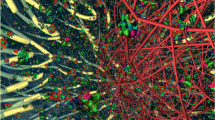Abstract
Biologists are building increasingly complex models and simulations of cells and other biological entities, and are looking at alternatives to traditional representations. Making use of the object-oriented (OO) paradigm, the Unified Modeling Language (UML) and Real-time Object-Oriented Modeling (ROOM) visual formalisms, and the Rational Rose RealTime (RRT) visual modeling tool, we summarize a previously-described multi-step process for constructing top-down models of cells. We first construct a simple model of a cell using an architecture in which all objects are containers, agents, or passive objects. We then reuse these architectural principles and components to extend our simple cell model into a more complex cell, the goal being to demonstrate that encapsulation familiar to artificial intelligence researchers can be employed by systems biologists in their models. A red blood cell is embedded in a straight-forward manner within a larger system, which is in turn iteratively embedded within still larger systems, including a blood vessel, a circulatory system, a human being, and a simple ecology. Each complexity increment reuses the same architectural principles, including the use of agents, each of which continuously either moves passive small molecules between containers, or transforms these passive objects from one type into another. We show how it is possible to start with a direct diagrammatic representation of a biological structure such as a cell, using terminology familiar to biologists, and by following a process of gradually adding more and more detail, arrive at a system with structure and behavior of arbitrary complexity that can run and be observed on a computer.
Similar content being viewed by others
References
M. Hucka et al., “Systems Biology Markup Language (SBML) Level 1: structures and facilities for basic model definitions,” http://sbml.org/documents/, 2005.
M. Hucka et al., “The systems biology markup language (SBML): a medium for representation and exchange of biochemical network models,” Bioinformatics, vol. 19, pp. 524–531, 2003.
W. Hedley et al., “A short introduction to CellML,” Philosophical Transactions– Mathematical Physical and Engineering Sciences, vol. 359, pp. 1073–1089, 2001.
System Biology Workbench, http://www.sbw-sbml.org 2005.
M. Tomita et al., “E-Cell: software environment for whole-cell simulation,” Bioinformatics, vol. 15, pp. 72–84, 1999.
P. Mendes “GEPASI: a software package for modelling the dynamics, steady states and control of biochemical and other systems,” Comput. Appl. Biosci., vol. 9, pp. 563–571, 1993.
P. Mendes “Biochemistry by numbers: simulation of biochemical pathways with Gepasi 3,” Trends. Biochem. Sci., vol. 22, pp. 361–363, 1997.
H. Sauro “JARNAC: a system for interactive metabolic analysis,” http://www.sys-bio.org 2000.
C. Morton-Firth and D. Bray “Predicting Temporal Fluctuations in an Intracellular Signalling Pathway,” Journal of Theoretical Biology, vol. 192, pp. 117–128, 1998.
J. Schaff et al., “Physiological Modeling with Virtual Cell Framework,” Methods in Enzymology, vol. 321, pp. 1–22, 2000.
L. Loew and J. Schaff “The Virtual Cell: A software environment for computational cell biology,” TRENDS in Biotechnology, vol. 19, pp. 401–406, 2000.
B. Slepchenko et al., “Computational Cell Biology: Spatiotemporal Simulation of Cellular Events,” Annual Review of Biophysics and Biomolecular Structure, vol. 31, pp. 423–442, 2002.
S. Khan et al., “A Multi-Agent System for the Quantitative Simulation of Biological Networks,” in Proceedings of the 2nd International Conference on Autonomous Agents and Multi-agent Systems (AAMAS'03), pp. 385–392, 2003.
P. Gonzalez et al., “Cellulat: An agent-based intracellular signalling model,” BioSystems, vol. 68, pp. 171–185, 2003.
D. Harel “Statecharts: A Visual Formalism for Complex Systems,” Science of Computer Programming, vol. 8, pp. 231–274, 1987.
D. Harel “On Visual Formalisms,” Communications of the ACM, vol. 31, pp. 514–530, 1998.
D. Harel “A Grand Challenge for Computing: Full Reactive Modeling of a Multi-Cellular Animal,” in Workshop on Grand Challenges for Computing Research, Edinburgh, Scotland, 2002. http://www.wisdom.weizmann.ac.il/~dharel/papers/GrandChallenge.doc
N. Kam and D. Harel et al., “Formal Modeling of C. elegans Development: A Scenario-Based Approach,” in Proceedings of Computational Methods in Systems Biology: First International Workshop (CMSB 2003), LNCS 2602, Rovereto, Italy, 2003, pp. 4–20.
I-Logix, I-Logix Rhapsody and Statemate. http://www.ilogix.com 2005.
IBM, IBM Rational Rose RealTime. http://www-306.ibm.com/software/rational/orhttp://www-306.ibm.com/software/awd-tools/developer/technical/, 2005.
J. Rumbaugh and I. Jacobsonand G. Booch, The (2nd edition) Unified Modeling Language Reference Manual, Addison-Wesley: Reading, MA, 2005.
B. Selic and G. Gulleksonand P. Ward, Real-Time Object-Oriented Modeling, John Wiley & Sons: New York, 1994.
K. Webb and T. White “UML as a cell and biochemistry modeling language,” BioSystems, vol. 80, pp. 283–302, 2005.
T. Quatrani Visual Modeling with Rational Rose and UML, Addison-Wesley: Reading, MA, 1998.
P. Kruchten The Rational Unified Process: An Introduction (2nd Edition), Addison-Wesley: Reading, MA, 2000.
W. Becker and J. Reeceand M. Poenie, The World of the Cell, 3rd ed, Benjamin/Cummings: Menlo Park, CA, 1996.
P. Mendes Gepasi 3.30. http://www.gepasi.org, 2003.
K. Webb and T. WhiteCombining Analysis and Synthesis in a Model of a Biological Cell, Symposium on Applied Computing (SAC 2004), Nicosia, Cyprus, 2004, pp. 185–190.
Author information
Authors and Affiliations
Corresponding author
Rights and permissions
About this article
Cite this article
Webb, K., White, T. Cell modeling with reusable agent-based formalisms. Appl Intell 24, 169–181 (2006). https://doi.org/10.1007/s10489-006-6937-9
Issue Date:
DOI: https://doi.org/10.1007/s10489-006-6937-9




